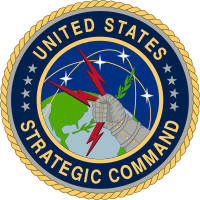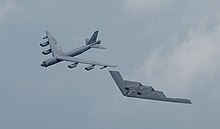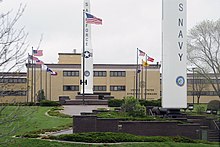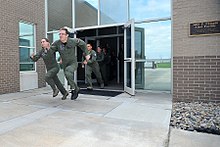

| United States Strategic Command | |
|---|---|

Official Emblem of United States Strategic Command.
| |
| Active | 1 June 1992 to present |
| Country | |
| Type | Functional Combatant Command |
| Role | Strategic deterrence, global strike, integrated missile defense, global C4ISR |
| Size | 150,000 personnel
14 Ballistic Missile Submarines 400 ICBM 154 bombers |
| Part of | |
| Headquarters | Offutt Air Force Base, Nebraska, U.S. |
| Nickname(s) | STRATCOM, USSTRATCOM |
| Motto(s) | Peace is our Profession ... |
| Website | www |
| Commanders | |
| Commander | Gen Anthony J. Cotton, USAF |
| Deputy Commander | VADM Richard A. Correll, USN |
| Chief of Staff | MG Gregory "Greg" Brady, United States Army |
| Command Senior Enlisted Leader | SgtMaj Howard L. Kreamer, USMC |
| Insignia | |
| pre-2002 seal |  |
| United States Armed Forces |
|---|
 |
| Executive departments |
| Staff |
| Military departments |
| Military services |
| Command structure |
|
Unified combatant commands
|
|
Combat support agencies |
|
|
The United States Strategic Command (USSTRATCOM) is one of the eleven unified combatant commands in the United States Department of Defense. Headquartered at Offutt Air Force Base, Nebraska, USSTRATCOM is responsible for strategic nuclear deterrence, global strike, and operating the Defense Department's Global Information Grid. It also provides a host of capabilities to support the other combatant commands, including integrated missile defense; and global command, control, communications, computers, intelligence, surveillance, and reconnaissance (C4ISR). This command exists to give "national leadership a unified resource for greater understanding of specific threats around the world and the means to respond to those threats rapidly".[1][2]
USSTRATCOM employs nuclear, cyber, global strike, joint electronic warfare, missile defense, and intelligence capabilities to deter aggression, decisively and accurately respond if deterrence fails, assure allies, shape adversary behavior, defeat terror, and define the force of the future.[3]



| Emblem | Command | Acronym | Commander | Established | Headquarters | Subordinate Commands |
|---|---|---|---|---|---|---|
 |
USFF | Admiral Daryl L. Caudle | 1 January 1906 | Naval Support Activity Hampton Roads, Virginia | ||
 |
AFGSC | General Thomas A. Bussiere | 15 December 1944 | Barksdale Air Force Base, Louisiana | ||
| MARFORSTRAT | Lt General Matthew G. Glavy | 1 October 2003 | Offutt Air Force Base, Nebraska |
The Global Operations Center, or GOC, is the nerve center for USSTRATCOM. The GOC is responsible for the global situational awareness of the commander, USSTRATCOM, and is the mechanism by which he exercises operational command and control of the Nation's global strategic forces.[1]


The Alternate Processing and Correlation Center in the USSTRATCOM Underground Command Complex at Offutt AFB provides an alternate missile warning correlation center to the Cheyenne Mountain Missile Warning Center. It is the prime source of missile warning data for USSTRATCOM for force survival and force management. The facility consists of the integration of the SCIS, CSSR, and CCPDS-R systems and also upgrade equipment and communications links.

U.S. Strategic Command's Airborne Command Post (ABNCP), also called "Looking Glass", allows USSTRATCOM the ability to command, control, and communicate with its nuclear forces should ground-based command centers become inoperable.[7]
USSTRATCOM was originally formed in 1992, as a successor to Strategic Air Command[8] in response to the end of the Cold War and a new vision of nuclear warfare in U.S. defense policy.[9][10] Department of Defense changes in command structure due to the Goldwater–Nichols Act of 1986, led to a single command responsible for all strategic nuclear weapons. As a result, USSTRATCOM's principal mission was to deter military attack, and if deterrence failed, to counter with nuclear weapons.[11]
Throughout its history, it has drawn from important contributions from many different organizations stretching back to World War II. Providing national leadership with a single command responsible for all strategic nuclear forces, General George Butler, in establishing the new command, borrowed from the work of General Curtis LeMay, an early commander of Strategic Air Command. LeMay was a very vocal advocate for a strong national defense, particularly as regards nuclear weapons.[10]
Being a Unified Command, another major concern for Gen. Butler was interservice rivalry, having soldiers, sailors, airmen and marines in one command.[10] There had been decades of rivalry between the branches of the U.S. military regarding control of nuclear weapons. Even though a compromise had established the Joint Strategic Target Planning Staff, there were systemic and institutional problems that could not be overcome.
USSTRATCOM was re-structured 1 October 2002 by Secretary of Defense Donald Rumsfeld.[9] It was now to merge with the United States Space Command and assume all duties for full-spectrum global strike, operational space support, integrated missile defense, and global Command, Control, Communications, Computers, Intelligence, Surveillance and Reconnaissance (C4ISR) and specialized planning.[8] Its duties now include intelligence and cyber support as well as monitoring orbiting satellites and space debris.
In February 2008, USSTRATCOM succeeded in destroying a satellite, USA193, about to re-enter the Earth's atmosphere.[12]
USSTRATCOM also supported United States Africa Command's 2011 military intervention in Libya in a variety of ways, including long-range conventional strikes and intelligence, surveillance and reconnaissance (ISR).[13]
An intention by the U.S. Air Force to create a 'cyber command' was announced in October 2006.[14] On 21 May 2010, part of USSTRATCOM's responsibility regarding cyber-warfare operations was spun off into a 10th Unified Command, the United States Cyber Command. As a result, USSTRATCOM's Joint Task Force-Global Network Operations (JTF-GNO) and Joint Functional Component Command – Network Warfare (JFCC-NW) were disestablished.
| No. | Commander | Term | Service branch | |||
|---|---|---|---|---|---|---|
| Portrait | Name | Took office | Left office | Term length | ||
| 1 | Butler, George L.General George L. Butler (born 1939) | 1 June 1992 | 14 February 1994 | 1 year, 258 days |  U.S. Air Force | |
| 2 | Chiles, Henry G. Jr.Admiral Henry G. Chiles Jr. (born 1938) | 14 February 1994 | 21 February 1996 | 2 years, 7 days |  U.S. Navy | |
| 3 | Habiger, Eugene E.General Eugene E. Habiger (1939–2022) | 21 February 1996 | 1 August 1998 | 2 years, 161 days |  U.S. Air Force | |
| 4 | Mies, Richard W.Admiral Richard W. Mies (born 1944) | 1 August 1998 | 30 November 2001 | 3 years, 121 days |  U.S. Navy | |
| 5 | Ellis, James O. Jr.Admiral James O. Ellis Jr. (born 1947) | 30 November 2001 | 9 July 2004 | 2 years, 222 days |  U.S. Navy | |
| - | Cartwright, James E.Lieutenant General James E. Cartwright (born 1949) Acting | 9 July 2004 | 1 September 2004 | 54 days |  U.S. Marine Corps | |
| 6 | Cartwright, James E.General James E. Cartwright (born 1949) | 1 September 2004 | 10 August 2007 | 2 years, 343 days |  U.S. Marine Corps | |
| - | Kehler, C. RobertLieutenant General C. Robert Kehler (born 1952) Acting | 10 August 2007 | 3 October 2007 | 54 days |  U.S. Air Force | |
| 7 | Chilton, Kevin P.General Kevin P. Chilton (born 1954) | 3 October 2007 | 28 January 2011 | 3 years, 117 days |  U.S. Air Force | |
| 8 | Kehler, C. RobertGeneral C. Robert Kehler (born 1952) | 28 January 2011 | 15 November 2013 | 2 years, 291 days |  U.S. Air Force | |
| 9 | Haney, Cecil D.Admiral Cecil D. Haney (born 1955) | 15 November 2013 | 3 November 2016 | 2 years, 354 days |  U.S. Navy | |
| 10 | Hyten, John E.General John E. Hyten (born 1959) | 3 November 2016 | 18 November 2019 | 3 years, 15 days |  U.S. Air Force | |
| 11 | Richard, Charles A.Admiral Charles A. Richard (born 1959) | 18 November 2019 | 9 December 2022 | 3 years, 21 days |  U.S. Navy | |
| 12 | Cotton, Anthony J.General Anthony J. Cotton | 9 December 2022 | Incumbent | 1 year, 202 days |  U.S. Air Force | |
In addition to the dramatic changes in the global landscape associated with the end of the Cold War, changes in the structure of the DoD stemming from the 1986 "Goldwater-Nichols Act" led national leaders to favor a single command responsible for all strategic nuclear forces. The new command's principal mission was to deter military attack, especially nuclear attack, on the United States and its allies and, if deterrence failed, to employ nuclear forces.
In 2011, it supported U.S. Africa Command's operations against Libya in a variety of ways, including long-range conventional strikes and ISR.
|
| |||||||||||||
|---|---|---|---|---|---|---|---|---|---|---|---|---|---|
| |||||||||||||
| Leadership |
| ||||||||||||
| Components |
| ||||||||||||
| Structure |
| ||||||||||||
| Operations and history |
| ||||||||||||
| Personnel |
| ||||||||||||
| Equipment |
| ||||||||||||
| |||||||||||||